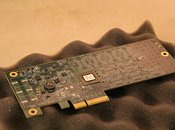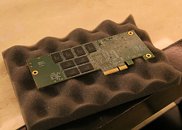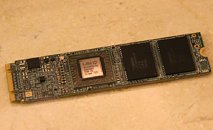- Joined
- Oct 9, 2007
- Messages
- 46,625 (7.66/day)
- Location
- Hyderabad, India
| System Name | RBMK-1000 |
|---|---|
| Processor | AMD Ryzen 7 5700G |
| Motherboard | ASUS ROG Strix B450-E Gaming |
| Cooling | DeepCool Gammax L240 V2 |
| Memory | 2x 8GB G.Skill Sniper X |
| Video Card(s) | Palit GeForce RTX 2080 SUPER GameRock |
| Storage | Western Digital Black NVMe 512GB |
| Display(s) | BenQ 1440p 60 Hz 27-inch |
| Case | Corsair Carbide 100R |
| Audio Device(s) | ASUS SupremeFX S1220A |
| Power Supply | Cooler Master MWE Gold 650W |
| Mouse | ASUS ROG Strix Impact |
| Keyboard | Gamdias Hermes E2 |
| Software | Windows 11 Pro |
Mushkin unveiled its second-generation Scorpion line of PCIe SSDs, which made its debut in June, 2013. A prototype of the series was shown at the 2014 International CES. The second-generation Scorpion leverages LSI's SandForce 3700 controller, which features both SATA 6 Gb/s and PCI-Express 2.0 x4 interface. In this implementation, the chip is wired to the latter, and is seated on a half-height add-on card with PCI-Express 2.0 x4 bus interface. The drive is bootable. All eight ONFI channels on the controller are populated by Toshiba-made 20 nm MLC NAND flash chips.
The controller is so highly integrated, that there are virtually no other components on the card, than itself, and the NAND flash chips. There are traces on the card for three large capacitors, which the controller can use for its bad power protection mechanism. When it senses a power failure or erratic power, the capacitors will supply enough power for the drive to finish its last safe write operation, and power down, to prevent data loss. In terms of performance, the controller offers sequential transfer rates as high as 1800 MB/s. Mushkin also showed off an M.2 drive based on the same controller, but with just four of its eight ONFI channels populated, which shouldn't be a problem, given that M.2 interface, with its two notches only offers 6 Gb/s interface speeds.



View at TechPowerUp Main Site
The controller is so highly integrated, that there are virtually no other components on the card, than itself, and the NAND flash chips. There are traces on the card for three large capacitors, which the controller can use for its bad power protection mechanism. When it senses a power failure or erratic power, the capacitors will supply enough power for the drive to finish its last safe write operation, and power down, to prevent data loss. In terms of performance, the controller offers sequential transfer rates as high as 1800 MB/s. Mushkin also showed off an M.2 drive based on the same controller, but with just four of its eight ONFI channels populated, which shouldn't be a problem, given that M.2 interface, with its two notches only offers 6 Gb/s interface speeds.



View at TechPowerUp Main Site
